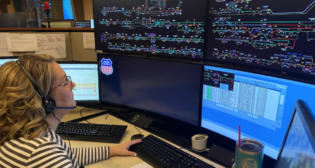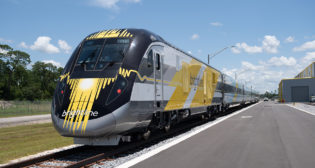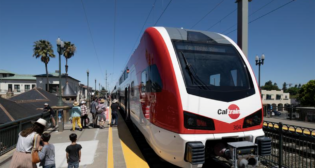
Canadian Railway Adventure (Updated)
Written by David Peter Alan, Contributing EditorAt this writing, I have completed two trips to Canada. They mark my first journeys to that country since shortly before the COVID-19 virus struck in 2020. The primary purpose of the trips was to ride the rest of the VIA Rail system, and I am planning to report on those trains soon. I did not venture west of Winnipeg, Manitoba, but journeyed far north of it, to Churchill. The other purpose was to ride Canada’s recent rail transit starts, which include lines in Kitchener-Waterloo and Ottawa, Ontario; and Montreal. There have also been some changes in Toronto, especially new streetcars.
Overview of Rail Transit in Canada
At this writing, I have ridden all of those lines completely, except in Calgary and Edmonton. Those cities are difficult to reach using non-automobile ground transportation; VIA Rail and intercity buses provide only sparse service, especially since the demise of Greyhound Canada. Transit agencies in both cities have expanded their systems since I last visited there about 15 years ago. The last expansion on Vancouver’s Sky Train system opened for service in 2016, and I rode it in 2020.
Toronto Strong, With Changes

Toronto’s transit system has often been rated the best in North America, including by advocates who consider it even better than New York’s. It comprises subways, streetcars and buses operated by the Toronto Transit Commission (TTC), the Union-Pearson Express (UPX) to the airport, and various commuter-length routes and buses in the suburbs operated by Metrolinx under the historic name “GO Transit.”

GO Transit has eliminated ticket agents; all sales are now through its app or through ticket machines. There are new weekend fares, C$10 for a day pass on Saturday or Sunday, or C$15 for both days, sold only on the app. Except on the Lakeshore East and Lakeshore West lines out of Toronto Union Station, most weekend service is operated on GO Transit’s buses (the bus terminal is near Union Station), although train service to Bramlea, on the way to Kitchener, has recently been increased on weekends.

The biggest change on the TTC is the introduction of Alstom (former Bombardier) Flexity Outlook streetcars on city’s system, the largest in North America. The new cars have five sections, and they look, ride and feel more like short articulated trains. The system is amazingly robust. The Queen Street line (#501) is currently running with a detour on McCall Street due to road construction. McCall is one of the north-south streets that still has its rails and overhead wire intact, even though that track and wire are not normally used in revenue service. Toronto still has other streets like that, too, and the TTC uses them when necessary.
Like many transit systems, TTC has a stored-value card, called the Presto Card. Beyond that, the streetcars feature full onboard fare collection, including a machine that allows riders to board and then pay a cash fare, dispensing a time-stamped paper that also acts as a transfer.
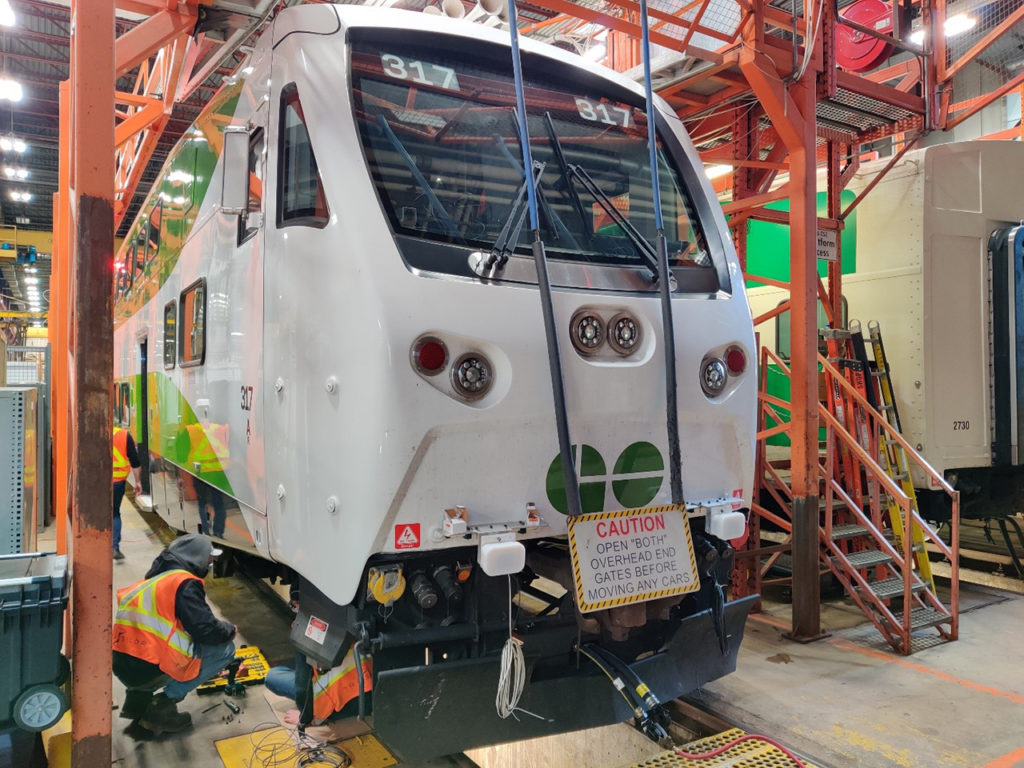
The most recent addition to the TTC Metropolitan-style rapid transit system is an extension at the northwest end of the U-shaped #1 (Yonge-University) Line to Vaughan that opened in 2017. The latest change was the elimination of the automated #3 Line (Scarborough Rapid Transit), which opened in 1985 and used alternative technology, and was shut down following a derailment on July 24. It will be dismantled and eventually replaced. For now, there is a temporary bus route.


There are more expansions coming. The #5 Eglinton Crosstown Line, a mostly underground line running north of the Bloor-Danforth on an east-west alignment, is scheduled to open next year. So is the #6 Finch West Line, an on-street line running westward from the #1 Line in the northern part of the city. These will be light rail lines. The next additions are projected for 2030-31: the extension of the #5 Line to replace the former Scarborough RT, and the Ontario Line. The latter would run primarily underground through downtown and then turn northeasterly from there. It would become the new #3 line.


LRT for Toronto’s Exurbs
Kitchener and Waterloo are adjacent towns, located slightly less than two hours west by southwest of Toronto. The latter is a university town, and the former has limited rail service on GO Transit, with most of the transportation in the area provided by buses. Grand River Transit runs the local bus routes and the ION light rail line, designated Route 301. The line runs with Alstom Flexity Freedom LRVs consisting of five sections, on 10- or 15-minute headways on weekdays and 15-minute headways on weekends.
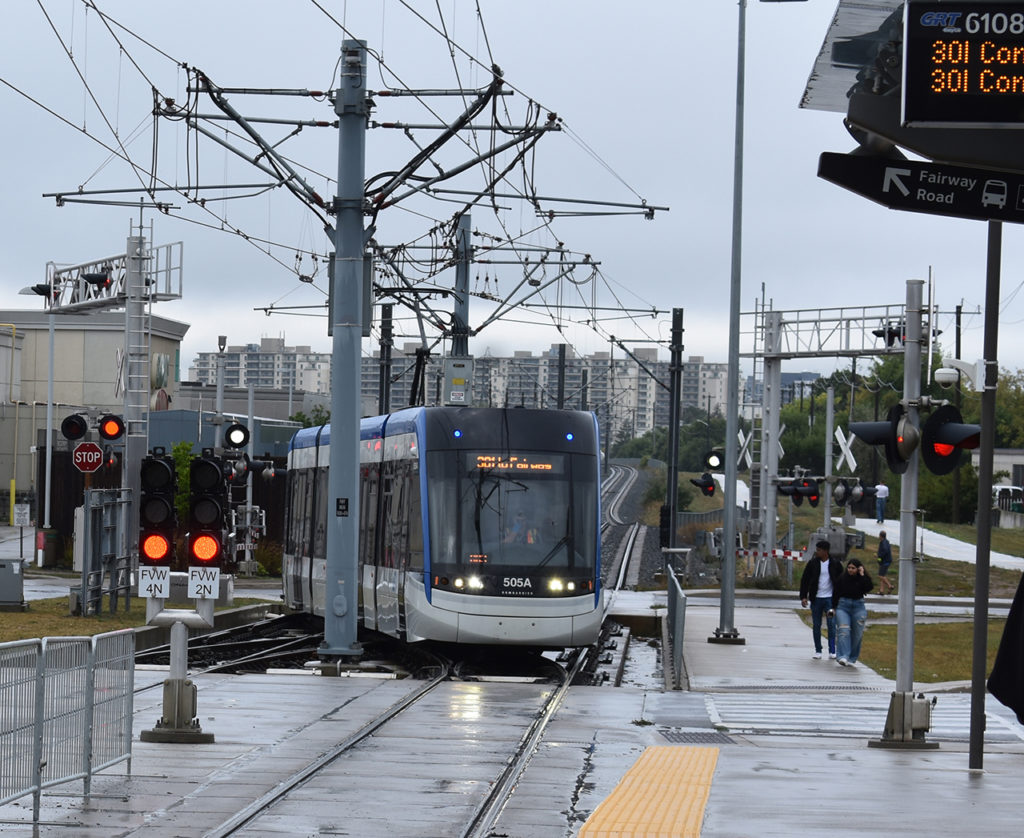
It took from 2004 until 2011 for local officials to plan and decide on the route and operation. Construction started in 2014, but service did not begin until June 21, 2019. The line was originally supposed to be called “The Wave” but the name was changed to ION in April 2013, after a survey indicated that 66% preferred ION because the name reflected the tech-savvy nature of the Waterloo region. The 19-km (12-mile) line is scheduled to take 43 minutes end-to-end. It serves downtown Kitchener, including the station used by VIA Rail and GO Transit, downtown Waterloo, and the University of Waterloo campus.
The base fare is C$3.75, and there is no discount for seniors, although many providers in the United States follow U.S. law and allow seniors to ride for half the base fare. In theory, Grand River Transit also offers a day pass for C$8.50, but visitors get an unpleasant surprise at the fare machine when they learn that the actual cost is C$13.50, which includes C$5.00 for the card that allows the visitor to purchase the day pass, a fact that is not stated explicitly on the provider’s website.
New Line in Ottawa

Ottawa’s original O-Train line ran on a north-south alignment west of downtown Ottawa. It is now called the Trillium Line and designated as Line 2, and it is out of service at this writing. When it comes back, it will connect with the new Confederation Line, designated as Line 1. That line’s initial segment is 12.5 km (7.8 miles) long and runs mostly at surface level, with 13 stations, three of which are in a tunnel under the downtown area, running under Queen Street and the Rideau Canal. It runs with Alstom Citadis Spirit LRVs, articulated units with four sections in open gangway style.
OC Transpo, the agency that runs the city’s transit, can couple two units together, but there were only single four-section units running when I rode. My visit was timed well, because the line had come back to service three days earlier, after a four-week shutdown caused by an issue with an axle bearing.
The Confederation Line, named after how Canada got started as a nation, runs a full service day. There are plans for several extensions going east and west from the present line, with the new segments to open in two to three years. There are senior fares in Ottawa, offering a slight discount from the base fare.
Service began on Sept. 14, 2019, but a headline in a story that ran on Nov. 19 in the Ottawa Citizen read: “Timeline: ‘The long, bumpy road to a public inquiry into Ottawa’s Confederation Line.’” When I took my ride, the equipment rode smoothly and the line seemed to be operating well, but it appears that the troubles are not yet over for Ottawa’s four-year-old LRT.
New and Different in Montreal

Montreal is the only city in Quebec sporting rail transit. The Montreal metro consists of four metropolitan-style subway lines, a commuter rail system called Exo with five lines that stress peak-commuting hours and run limited service at other times, and something new: the driverless REM (Réseau Express Métropolitaine) Line. The latter is a different type of LRT, now running between Central Station in downtown Montreal and Brossard, across the St. Lawrence River and southeast of the city.

REM service began on July 31, 2023, amid service disruptions caused by stuck switches and computer problems during the first three days of operation. The schedule calls for frequent service and a full service day, with a running time of 20 minutes for the starting segment now in operation. The trains consist of Alstom Metropolis two-car units, often with two such units running together. Seating is longitudinal, and the cars appear to have a wide interior, possibly due to the picture window that runs the full width of the car, since the operation is automated and cabs are not necessary.
The existing segment begins at Central Station, which also serves VIA Rail and two Exo lines. Most of the line runs along the median of a highway, and current stations do not appear to be close to populated areas, although the REM fare includes a transfer to local bus service. There are several extensions planned, which the line’s proponents claim will all be operating by 2027, with some segments running as early as next year. One new start will be the restoration of service to Deux-Montagnes, a former CN commuter line through the Mount Royal Tunnel and the Village of Mount Royal that began service in 1918, was refurbished extensively and re-equipped in 1995, and was shut down on Dec. 31, 2020 to build the new REM line that will replace it. That line is under construction and is slated to open at the end of 2024. So is a new branch from that line to Anse-à-l’Orme, which will consist of four stations. Another branch will go to the airport and is expected to start service in 2027. While the line has had its controversies, primarily political ones, everal other proposed extensions have been mentioned.
The REM fare is high, C$4.50 each way and without a senior discount. There is a way to ride for less, and the crowded train I rode seemed to prove the point. In addition to a day pass (for C$11.00, good only within Montreal city limits), an “evening pass” is available for C$6.00. It is good on the REM line, as well as Metro subway lines and buses in all fare zones. It is valid from 6:00 PM (the fare machines are strict about the time) until 5:00 the next morning. There is no rail transit after about 1:00 AM, but there are some bus routes that run all night.
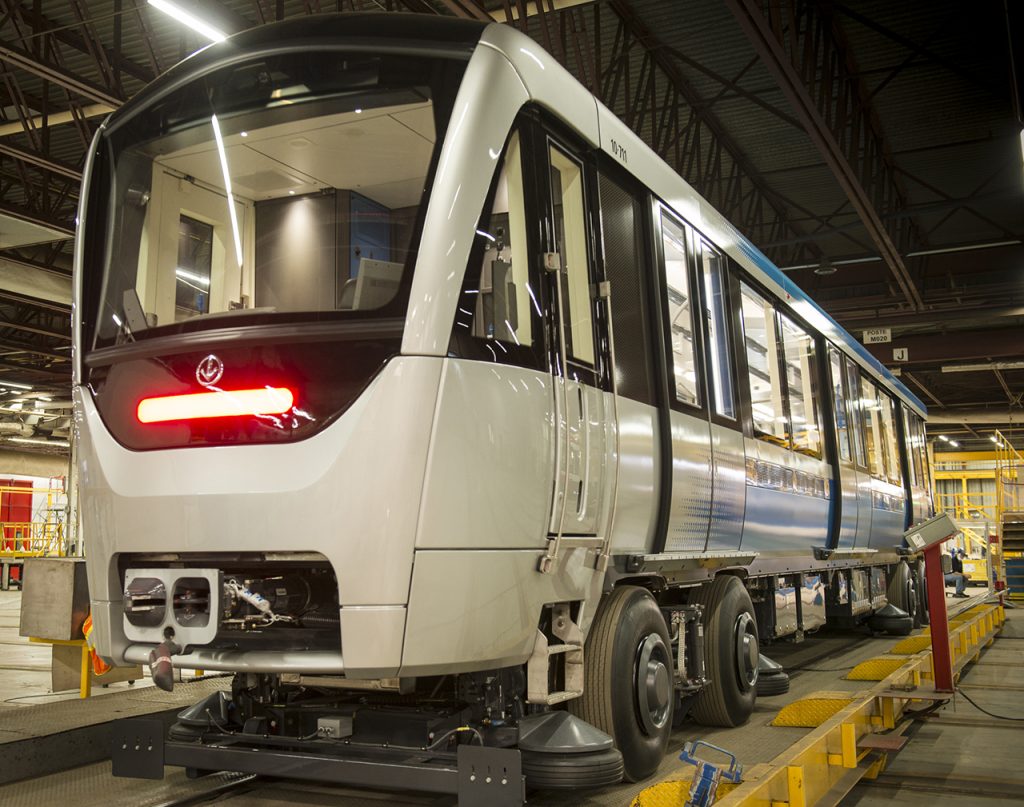
The Metro subway system run by the Société de Transport de Montréal (STM) started in 1966, shortly before Expo 67 ran in the city to celebrate Canada’s 100th anniversary as a country. Today it consists of four self-contained lines running entirely underground. The #1 Green and #2 Orange Lines are long, the former running from southwest to northeast through downtown, the latter running on a U-shaped alignment that includes a downtown segment under a different street. The #5 Blue Line, 12 stops long, runs roughly parallel to the other two and northwest of them. The shortest line is the #4 Yellow Line, which runs from Longuil on the East Shore of the river to the busy transfer station at Berri-UQAM, with only one intermediate stop. The city’s bus terminal and the Montreal campus of the University of Quebec are located near that station, which also serves as the transfer point for the #1 and #2 lines. There is no #3 Line, although early plans called for it to run in the Mount Royal Tunnel, which will be used for the REM line.
The original Green, Orange and Yellow Lines were in service during Expo 67, and the Green and Orange lines have expanded over the years. The Blue Line opened in 1986 and 1988 in four segments, and the system reached its current size in 2007. There are plans for a northeasterly extension of the Blue Line toward Anjou, which is slated to begin service in 2028 or 2029.
Metro trains use rubber tires, which run on running pads located outside the steel rails (as in Paris and Mexico City). As with most Metropolitan-style lines, 750-volt power is collected through a third rail. The original Canadian Vickers cars from the early days of the system ran until 2018. Bombardier MR-73 cars from 1976 run on the Blue and Yellow Lines, and sometimes on the Green Line today. The new Alstom MPM-10 cars that entered service in 2016 run on the Green and Orange Lines. The trains are long and articulated, with the open-gangway style of interior stretching the length of the train. The Metro system is famous for its artfully designed stations and public architecture, some of which can be seen from the train on platform walls.
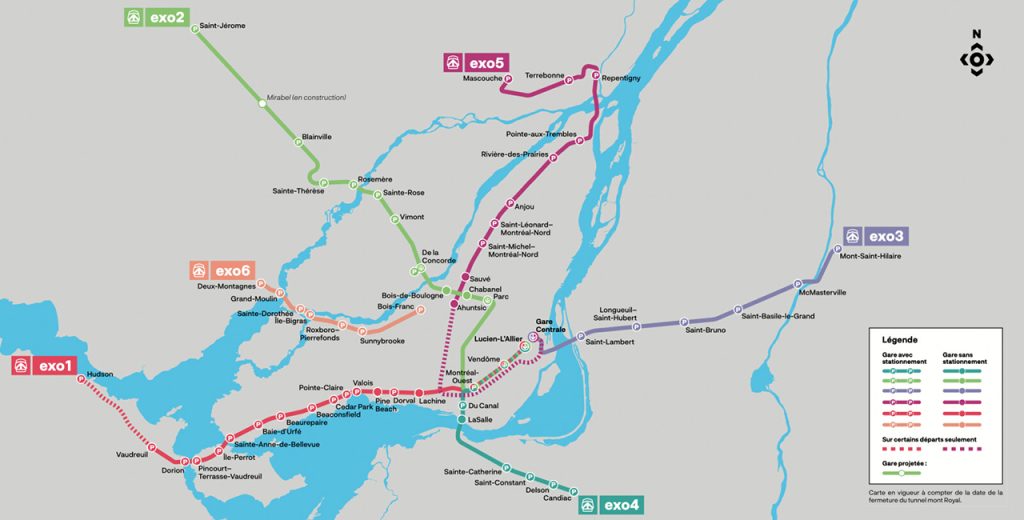
Montreal has commuter rail lines, too and, in that city’s case, the description fits. The Deux-Montagnes line, which will become an REM line, was the busiest. Service is strong during traditional peak commuting hours, but much more limited at other times on the five remaining lines. They radiate from downtown in different directions: to Vaudreuil (west, with a single train going one more stop to Hudson), Saint-Jérôme (northwest), Candiac (southeast), Mascouche (north), and Mont Saint-Hilaire (northeast, toward Quebec City). The first three lines run on Canadian Pacific (CP, now part of CPKC) track from Lucien-L’Allier Station, near the location of CP’s former and historic Windsor Station. The other two run on CN, from Central Station, home of VIA Rail and the REM Line. Trains first ran on the line to Saint-Hillaire in 1859 and on the historic CP lines during the 1880s. The most recent start is the Mascouche Line, which started service in 2014, using Bombardier MultiLevel cars and ALP-45DP dual-power locomotives, virtually identical to those in use on New Jersey Transit. This equipment is now used on all lines. EMD F59PH locomotives from 1990 and F59PHI units from 2000 are also in use on the historic CP lines and the Mont-Saint-Hillaire line. New Siemens Charger locomotives and CRRC bilevel railcars are on order.


A Nation With Few “Transit Cities”
Of the seven places with rail transit in Canada, only three have significant systems: Toronto, Montreal, and Vancouver. In Alberta, rival cities Calgary and Edmonton have two LRT lines each and plan to expand their systems with one more major line. There are plans to expand Ottawa’s O-Train system, and perhaps even the ION line in Kitchener-Waterloo, but it also unlikely that either of those locations will end up with large-scale rail transit systems.
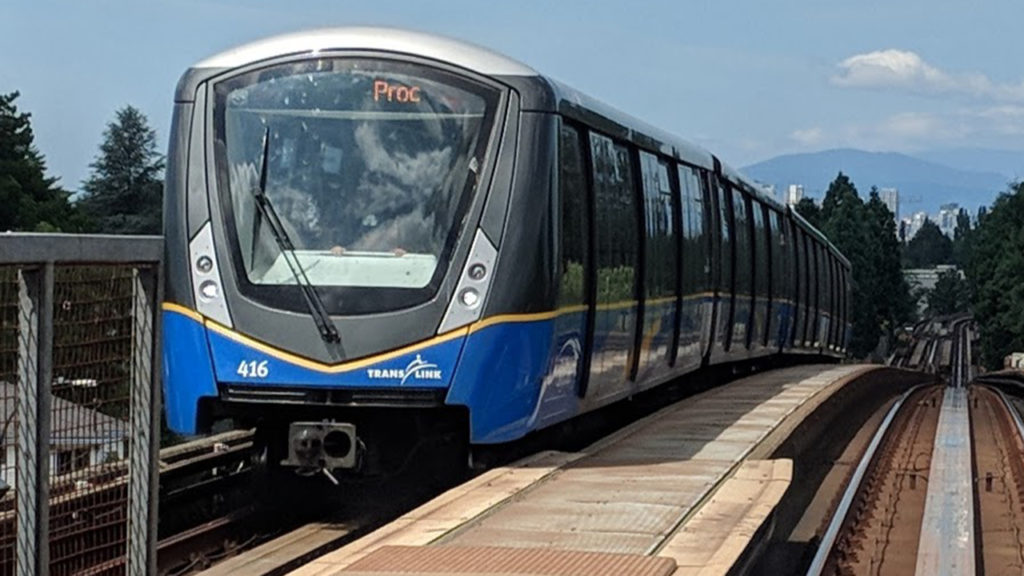
Vancouver’s Translink Sky Train system has grown over the years and connects the city with its suburbs. The West Coast Express commuter line runs only a few trains for peak hour commuters, and there is also the Sea Bus, a ferry to North Vancouver that is heavily used.
Montreal’s system is diverse, with Metro and REM, and Exo for commuter trains. There are expansion plans, most notably for REM, and transit is well-patronized, especially on the Metro lines.
That said, Toronto’s system is in a class by itself. The city has long and popular subway lines and is planning to build more. It also has the most robust and redundant streetcar system in North America, and the TTC has made the investment to purchase its new low-floor streetcars and keep tracks and wires on routes that are not normally used in revenue service. While most lines on the region’s GO Transit system run only during peak commuting periods on weekdays, service at other times is gradually increasing and supplemented by a large bus network. If one North American city serves as a model for comprehensive, well-run transit that is heavily patronized by the locals, it’s Toronto.
Will rail transit expand in Canada? Maybe, but probably not much. After a years-long struggle, Hamilton might get light rail someday. That city is located about one hour form Toronto, on the way to Niagara Falls. GO Transit trains go near there during peak commuting hours, connecting with buses to and from Hamilton. There will someday be more rail transit in densely populated Southern Ontario, when Metrolinx’s north-south Hazel McCallion Line (previously named the Hurontario) LRT opens in Mississauga.
Elsewhere in Canada, though, not much is happening. In other big cities, like Halifax, Quebec City and Winnipeg, it seems unlikely that rail transit will appear within the foreseeable future. There are good bus systems in Canada, and Winnipeg has one of the best. Still, even the best bus service is not like a rail line.
This should not come as a surprise, considering that non-automobile intercity transportation is very sparse throughout much of the country. VIA Rail runs its corridor operations in Ontario and Quebec, serving such cities as Toronto, Ottawa, Montreal and Quebec City. Still, there are no corridor trains west of Walkerville, Ontario, just short of Windsor, which is located across the St. Claire River from Detroit (a city that now has a single streetcar line). Elsewhere in Canada, VIA Rail trains only run two or three times a week. There are not many buses, either, especially since Greyhound Canada bit the dust even before the COVID-19 virus struck and VIA Rail did not increase service to fill the vacuum.
I will have more to report about VIA Rail soon, especially its long-distance trains which, according to VIA Rail’s promotional literature, promise an adventure. I rode, and I can say they delivered one to me.
Tourist Railroads, Museums Highlight Canadian Railroad History
Railroad museums and “Heritage Railroads” (as tourist railroads are known in Canada) dot the country, but many are located in Ontario. Some are near Toronto. As part of the trips I took to Canada to complete travel on the VIA Rail system and ride new (or relatively new) rail transit starts, I found one such railroad and two museums in Ontario, another museum near Montreal, and a day trip on a tourist railroad from Quebec City that justified taking the side trips.
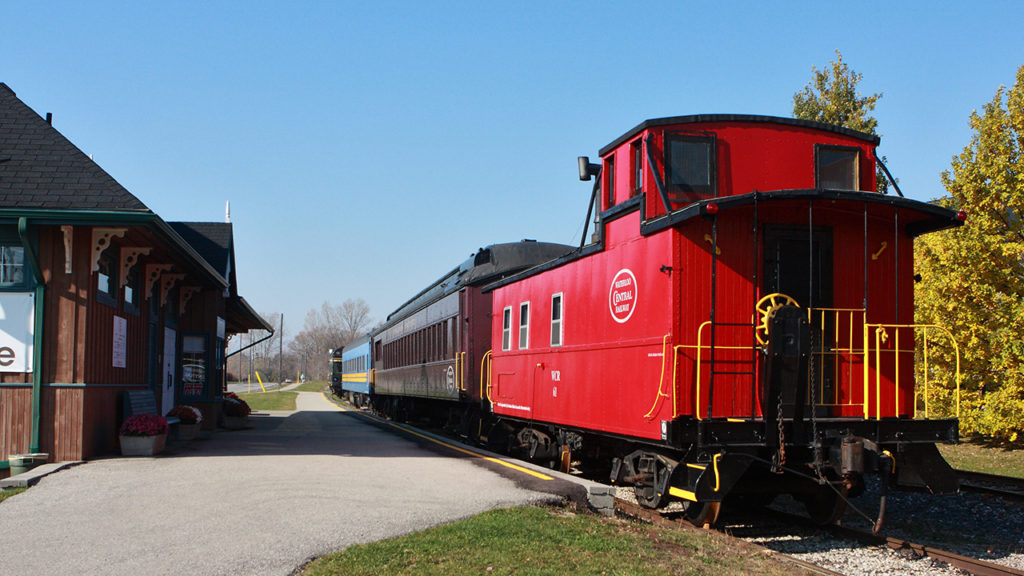
The new ION LRT in Waterloo goes to a station called Northfield, one stop from the northern end of the line. There it connects with the Waterloo Central Railway, a heritage railroad that runs excursions on Tuesdays, Thursdays, Saturdays and Sundays in season. The railroad runs several themed trains, but the standard run is the Heritage Hopper, a train between Waterloo and Elmira through the historic town of St. Jacobs. The current schedule calls for departures at 10:00, 12:00, and 2:00 from Northfield, with stops at the St. Jacobs Farmers’ Market and historic downtown St. Jacobs, on the way to a quick turnaround at Elmira in a location far from that town’s center. Trains arrive back at Northfield two hours later, with the last arrival at 4:00. They only run on Thursdays and Saturdays in September and October, and there is no 10:00 departure on Sundays.
The Farmers’ Market is huge, with several buildings full of food vendors, craft items for sale, displays with an agricultural flavor, and entertainment. The time I had was long enough to get the flavor of it, but not to give all of it a thorough examination. The next stop is downtown St. Jacobs, a quaint and historic town, especially on its main street, King Street, which is lined with shops and eateries. Two hours was enough to get the flavor of the town, but probably not enough to walk around it, have lunch, and see the town’s other railroad attraction: the St. Jacobs & Aberfoyle Model Railway.

Housed in a building off King Street, it contains a small collection of the sort of artifacts that are often found in railroad museums, and that were interesting. The impressive feature of the facility is the model railway layout. It takes up more than 100 linear feet of space and is one of the largest and most-detailed layouts I have seen in the United States or Canada. There are many trains making their way around the layout, and the level of detail of the buildings, mountains, bodies of water and other scenery are amazing. The C$10.00 admission charge might seem a bit high, but the layout is spectacular, and provides something unusual to do during a visit to St. Jacobs. The museum needs a new home and is appealing for funds, although it is an attraction that appears worth saving. It is open on weekends and most holidays. The museum’s website is www.stjacobsmodelrailway.com.
The Waterloo Central was originally opened in 1891 as the Waterloo Junction Railway. CN bought the six-mile (10-km) line in 1921. Since 1990, it has been operated off and on as a tourist railroad by several different operators. In 2007, it started running as the Waterloo Central Railway with volunteer crews. In 2015 it left Waterloo and began operating from the St. Jacobs Farmers’ Market, and today it connects with ION at Northfield.
The railroad has steam locomotives, as well as diesel units from the late 1950s. The cars also had a nostalgic quality. Our consist had three cars. One was a CN coach that ran on long-distance trains, similar to ones I rode in the 1970s and 1980s. There were also two Budd RDCs. One had run on the British Columbia Railway (originally Pacific Great Eastern) before that railroad discontinued its passenger trains in 2002. The other had been modified into an extra-fare car, with tables at one end and easy chairs arranged longitudinally along most of the car’s length, like the parlor cars of another era.
It is tricky to see everything in the area in one day, but it is possible on a Saturday. The first bus from Toronto leaves the downtown bus terminal at 7:51 AM and arrives at the ION station at the University of Waterloo too late to make a transit connection to Northfield Station in time for the 10:00 AM departure. Instead, the 10:29 AM departure of the local 19A bus gets to the market at 10:50 AM, allowing roughly 75 minutes to see the market and grab some lunch before catching the train that left Northfield at 12:00 PM for downtown St. Jacobs (the second departure of the day). That schedule provides two hours in St. Jacobs before re-boarding to catch the third run to Elmira and back to Northfield to end the service day. After arriving there, it was time to ride the ION line in its entirety and see some of downtown Kitchener and Waterloo before taking the bus to Bramlea and a connecting GO Transit train from there to Toronto.
The other railroad museum is in a more-remote location, but also a town with railroad history and that still hosts trains on VIA Rail. It is the Northern Ontario Railroad Museum, located in Capreol, a “railroad town” on CN, about a seven-hour ride west of Toronto on VIA Rail’s transcontinental Canadian, which only runs twice a week. Westbound VIA Train 1 is scheduled to arrive at 5:22 PM on Sundays and Wednesdays, while Eastbound VIA Train 2 goes through the area in the middle of the night, scheduled to stop at 3:47 AM on Tuesdays and Fridays.

Capreol was the place where the Montreal and Toronto sections of CN’s Continental Limited and other transcontinental trains joined or split on their way to or from points west as far as Vancouver, with separate sections coming from or going to Montreal and Toronto. Sudbury, about a 45-minute ride from Capreol on a local bus, served the same purpose for CP Rail until 1990, in the days when the Canadian train ran on its original route.
The railroad museum is located in Capreol’s most historic house, the railroad superintendent’s house, built in 1916. There are exhibits inside that are typical of railroad museums, as well as some artifacts that tell the history of the town and its other major industries: logging and mining. Outside is an interesting variety of equipment, mostly from CN. Engine 6077, a Mountain-type steam locomotive, is part of the museum’s collection and is located outside in adjacent Prescott Park. The collection also includes a 1907-vintage steam unit from the Temiskaming & Northern Ontario Railway, which is now the Ontario Northland Railway. It also includes railroad tools and equipment, a CN caboose with the cupola at one end, and an electric locomotive used by the International Nickel Company (INCO) in its mining operations.
One of the most unusual artifacts is a “boxcar house,” a small house that was made from a wooden boxcar, and that housed a railroad worker and his wife during the 1930s. Despite its small size, it looked comfortable and seemed to have room for the necessities of life. The other is a “School Car” that was used by a teacher who taught in remote places along the line. He taught every subject, from first grade to a few college-level courses, as well as language and literacy for adults in the evening. The car contained more than just a classroom. It also had a small library, as well as living quarters for the teacher and his wife.
The Heritage Centre in Capreol is affiliated with the railroad museum and located in a former firehouse a block away. It contains a 1928-vintage fire engine and exhibits about the civic history of the town and its police and fire departments, including two jail cells in the basement. Elsewhere in the basement is a model railroad layout that is impressive in its own right, although not as impressive as the one in St. Jacobs. It took about five hours to see both museums, have lunch, and take a walk around the town.
The Montreal area has a railroad museum, too, and it is accessible on an Exo train on weekdays. It is ExpoRail, located in Saint-Constant, on Exo’s Candiac line. The museum’s website, www.exporail.org, claims that it is “the biggest railway museum in Canada,” with 179 “life-size railway vehicles” in the collection. Most are on display in what looks like a twelve-track train shed. There are other indoor exhibits typical of those seen in railroad museums. Other equipment is parked outside, and several other buildings are open. There is also a short ride on a 1928-vintage Montreal streetcar available for an extra C$2.00, in addition to the price of museum admission. The museum is open from 10:00 to 5:00 every day in summer, and Wednesdays through Sundays in September and October. From November until mid-May, only the indoor exhibits are open on Fridays, Saturdays and Sundays. Adult admission is C$22.00 (about $16.00 U.S.), with discounts for seniors, students and children, as well as a family rate.

It is possible to take the train to the museum on weekdays, but the trip is tricky. The museum is located about two blocks from the Exo Saint-Constant station; walking time to the museum is about 10 minutes. To visit the museum, take Train #77 from Lucien-L’Allier Station at 9:35 AM, which is scheduled to arrive at Saint-Constant at 10:05. That is the first train from Montreal. The return train is #86, which leaves Saint-Constant at 1:27 PM, the last train back to downtown Montreal. For an all-rail trip, that allows three hours to see the museum. Another option is to ride the rest of the line to Candiac and return to Saint-Constant on Train #84, which is scheduled to arrive there at 10:37. That option reduces the amount of time at the museum to 2½ hours, but it was enough time for me to see everything, even though I felt slightly pressed for time.
There is also a major tourist railroad in Quebec: the Train de Charlevoix, which runs from Quebec City to La Malbaie (Murray Bay), on the Charlevoix Railway, along the north shore of the St. Lawrence River. The experience is a day trip that leaves from a station near Montmorency Falls in Quebec City about 9:00 AM and is scheduled to return between 6:00 and 6:30. The route runs along the rugged river shore, rocky in many places, with a few stretches of beach, some houses, mud flats, and lots of rocks. The line is about 90 miles (145 kilometers) long. The official schedule calls for a running time of 4½ hours from end to end, but there is a great deal of slack in it, and the actual trip took roughly 3¾ hours.

The company that operates the tourist operation also owns the railroad (known in French as Chemin de fer Charlevoix, with reporting mark CFC). The corporate name for the owner is Train Touristique de Charlevoix, Inc., and the company also owns the Le Massif ski area, located between Sainte-Anne-de-Beaupré and Baie-Saint-Paul. There are winter ski trains to the resort, now operated by Club Med. The railroad interchanges freight at the Port of Quebec City, and CN has trackage rights for freight service.
The railroad offers several packages to different places along the route, and details can be found on its website, www.traindecharlevoix.com. The train is a seasonal operation. At this writing, departures are scheduled every day through Sunday, Nov. 5. While my specific objective was to ride the entire line, a separate train goes to Baie-Saint-Paul, a town about one hour upriver from La Malbaie, and noted for its art scene. It features museums and historic buildings and is considered the cultural center of the Charlevoix region. Another destination, although less popular, is Sainte-Anne-de-Beaupré, a significant Catholic religious site. The original Quebec, Montmorency & Charlevoix Railway reached there in 1889, and locals called it the “Railway of Good Saint Anne,” even before it was electrified (1904-59) and extended further east.
CN ran passenger service on the line until VIA Rail took it over in 1977, but it was discontinued later that year. After that, several operators ran it as a tourist railroad, including one that ran a dinner train operation. Today the railroad is owned by the company that operates the trains. The current operation began in 2011, succeeding one that began in 2008, after the track was upgraded with the help of grants from the federal and provincial governments.
The current operation runs married pairs of DMU (diesel multiple-unit) railcars with seating capacities of 121 and 128 per unit. The units were built by Daimler-Benz in 1981 for Deutsche Bahn. The cars have a 2-2 seating configuration, half the seats face backwards, and there are some pairs of seats facing each other, with a narrow table between them. The railroad sells the seats on both sides of a table as a block for four single fares, which encourages groups of four to purchase table seats and sit together. Single fares are slightly higher for the “river side” of the train than for the “mountain side,” a difference that makes sense. There are some towns and houses on the mountain side, but there are also cliffs, and the rail line is located at the bottom of those cliffs. The river side was more scenic.
The train is accessible from downtown Quebec City by local bus, but it is tricky to get to the station from the bus stop. From downtown, the ride on the #800 bus (a major route, which generally runs every 15 minutes) takes about 25 minutes and terminates at a park near the top of Montmorency Falls. The view of the falls from the bottom is spectacular, and that is where the station is located. Getting between the bus stop and the station is tricky, a relatively long walk through a large park, complete with a difference in elevation. The trip itself was pleasant. I rode on Sunday, Sept. 3; a hot day in Quebec City. The train was more than 75% full. From what I could tell, most of the riders were Quebecers who only spoke French. The crew operated in that language, too. I was one of the few riders who did not speak French, but the crews and a few other riders were helpful, and I was able to get by in English.
La Malbaie, the ultimate destination, is a small town, on the north shore of the St. Lawrence River, opposite a point between La Pocatière and Rivière-de-Loup, two towns on the south shore that are served by VIA Rail’s Ocean. The town’s name means “bad bay,” a description that came from explorer Samuel du Champlain,, who explored the area in 1605 and later founded Quebec City. The town became a mecca for “rich and famous” tourists during the 20th Century, and hotels like Le Manoir Richelieu (opened in 1899 and rebuilt in 1929) catered to them. The town was known as “the Newport of Canada,” and U.S. President William Howard Taft (1909-13) was a regular summer visitor for years.
I did not see that part of the town as I stepped off the train for a one-hour visit. What I did see was a pleasant though not awe-inspiring neighborhood that featured a beach area, one that did not have the upscale appearance of the more-affluent parts of the Jersey Shore. Chez Chantal, the local snack shack sells fries, burgers, chicken, sandwiches, lobster rolls, and poutine, a mix of fries, cheese chunks and gravy invented in Quebec in the 1950s and now a Canadian “diner classic.”

Canadian Experiences
Between ride on the Train de Charlevoix and the hour at the end of the line, the trip provided a railroad experience that exudes the flavor of Quebec, in a way that an excursion, even from Montreal, could not. In a similar way, the Waterloo Central provided an experience that could probably not be found outside Ontario. The two railroad museums in Ontario both had their own local flavor and were different in style, the only similarity being the high level of craftsmanship displayed in their layouts. As for Rail Expo near Montreal, that museum features a large collection of equipment from Canada’s two major railroads, CN and CP. Still, much of the equipment in the collection, including the streetcars, ran in Montreal. While “national” in scope, the museum never got away fully from its roots in Montreal.
I have focused only on museums and I saw and tourist railroads I rode recently. There are other examples of both in Canada. Many are not accessible except by automobile, which means that non-motorists who must use a train (or a bus, if necessary) do not have access to them. There are also some located in or near cities, and can be reached by a train or bus, with a segment on local transit.
While it is difficult to travel in Canada without an automobile and train service is limited outside of VIA Rail’s corridors in Ontario and Quebec, Canadians continue to celebrate their railroad heritage, just as many Americans do. There might not be many railroad-themed attractions that are accessible by train in either country anymore, but at least there are some.

David Peter Alan is one of America’s most experienced transit users and advocates, having ridden every rail transit line in the U.S., and most Canadian systems. He has also ridden the entire Amtrak network and most of the routes on VIA Rail. His advocacy on the national scene focuses on the Rail Users’ Network (RUN), where he has been a Board member since 2005. Locally in New Jersey, he served as Chair of the Lackawanna Coalition for 21 years, and remains a member. He is also Chair of NJ Transit’s Senior Citizens and Disabled Residents Transportation Advisory Committee (SCDRTAC). When not writing or traveling, he practices law in the fields of Intellectual Property (Patents, Trademarks and Copyright) and business law. Opinions expressed here are his own.
